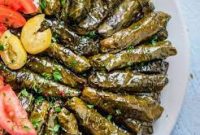“Bountiful Traditions on the Plate: An In-Depth Exploration of the Culinary Heritage of Albania”
Bountiful Traditions on the Plate
Introduction:
Taking a culinary journey across Albania’s picturesque scenery reveals a culinary treasure that foodies everywhere have to discover. The rich tapestry of Albanian history is reflected in its food, which is sometimes disregarded and combines traditional culinary methods, locally available products, and a variety of cultural influences. We go deeply into Albania’s culinary legacy in this thorough investigation, learning about the peculiar tastes, age-old recipes, and regional variations that create a singular and mouthwatering sensory experience.
A Symphony of Flavors: Traditional Albanian Dishes
- Flija: Layers of Delight
The multi-layered pancake known as “Flija,” which shows the patience and accuracy inherent in traditional cooking, is tucked away among the culinary gems of Albania. Made by dividing batter into thin layers and baking each one separately, Flija is typically consumed during festivities, highlighting the sense of community that permeates Albanian get-togethers.
- Qofte: Savoring the Sizzle
Albanian meatballs, or qofte, are a great example of how skilled cooks can combine basic ingredients to create delectable dishes. Qofte, made with minced pork, onions, and a mixture of spices, is a flexible dish that is served on tables all across the nation and can be grilled, fried, or stewed.
- Petulla: The Sweet Embrace
Petulla is a common street dish in Albania and a sweet treat in households. It is deep-fried dough sprinkled with powdered sugar. With each crispy bite, this easy-to-make but delicious dish embodies the spirit of Albanian comfort cuisine.
Savoring Diversity: Influences Shaping Albanian Cuisine
- Illyrian Roots: Ancient Foundations
The ancient Illyrians who once inhabited the area are the source of Albanian cuisine. The use of straightforward, locally available ingredients has been a recurring theme linking current Albanian cuisine to its historical roots, even though certain recipes may have changed over the years.
- Ottoman Influence: A Culinary Tapestry
Albania was ruled by the Ottoman Empire for several centuries, and this had a lasting impact on the country’s cuisine. Albanian cuisine is enhanced by the Ottomans’ introduction of spices, herbs, and cooking methods, which results in a singular blend that captures the richness of the region’s history.


Gastronomic Treasures: Unique Ingredients of Albania
- Wild Mountain Herbs: Aromatic Wonders
Many different wild plants may be found in the hilly scenery of Albania. These herbs, which include sage, thyme, and oregano, give Albanian cuisine a unique and fragrant flavor that captures the spirit of the nation’s abundant natural resources.
- Fasule: The Albanian Bean
In Albanian cooking, false, or white beans, have a specific role. Fasule is a common item in Albanian homes, embodying the simplicity and adaptability of ingredients present in the country’s kitchen, whether it is cooked with meat or used in vegetarian cuisine.
Regional Delights: Exploring Albanian Culinary Diversity
- Gjirokastra: A Citadel of Flavors
A UNESCO World Heritage site, Gjirokastra has a rich gastronomic legacy to match its historical significance. Recipes such as Gjizë, a local sheep’s milk cheese, highlight the distinctive tastes of the area.
- Korca: A Culinary Tapestry Unraveled
Known for its thriving food scene, Korca is praised for the wide variety of mezes, which are tiny plates that encapsulate Albanian hospitality. The region’s commitment to taste and quality is evident in Korca’s culinary offerings, which range from pickled vegetables to smoked meats.
Modern Resonance: Albanian Cuisine in the Contemporary Culinary Scene
- Reinventing Tradition: Chefs and Innovators
Albanian chefs and culinary innovators have taken on the task of pushing the boundaries of cuisine while maintaining tradition in recent years. Restaurants all around the nation are bringing a contemporary twist to traditional dishes, drawing in both residents and visitors to enjoy the changing Albanian culinary landscape.
- Global Recognition: Albania’s Culinary Renaissance
Albania’s gastronomic revival is becoming more and more recognized on the international scene. With an emphasis on sustainability, quality, and authenticity, Albanian food is gaining recognition in the world of gastronomy and piqueing interest from people all over the world.


Conclusion:
As we come to the end of our exploration of the vast and varied world of Albanian cuisine, it is clear that the country’s culinary legacy is a celebration of custom, tastes, and a close bond with the land. The rich layers of influence from Ottoman, Mediterranean, and Illyrian civilizations, as well as the simplicity of Flija, make Albanian cuisine a monument to a people’s adaptation and perseverance over time. The world is discovering that Albanian cuisine is not just a gastronomic gem but also a vibrant, living representation of the identity and legacy of a country, welcoming everyone to enjoy the many customs on the plate.




